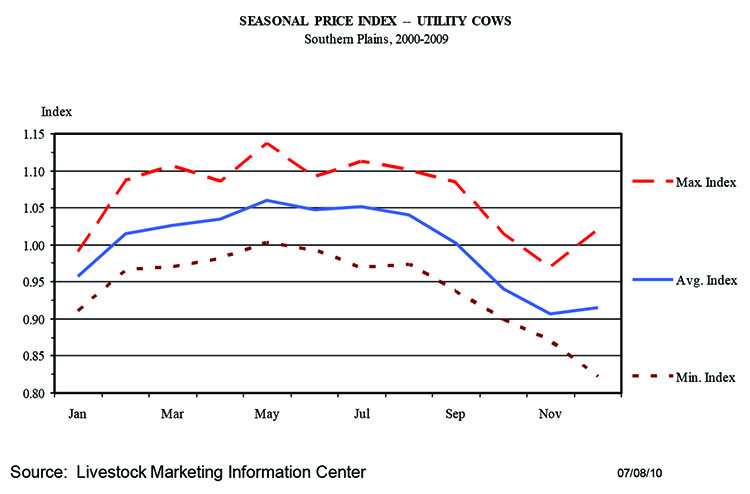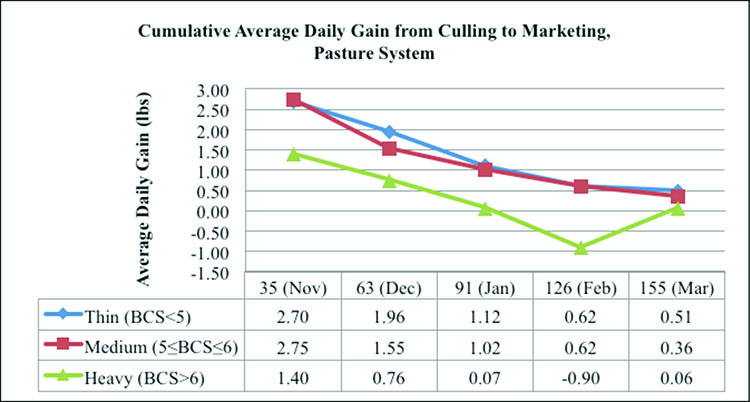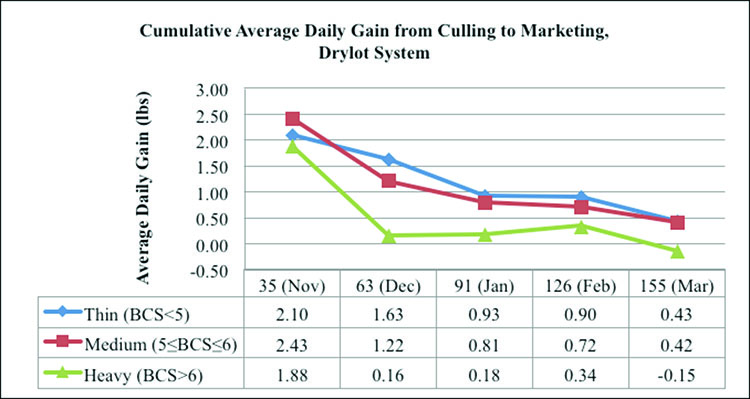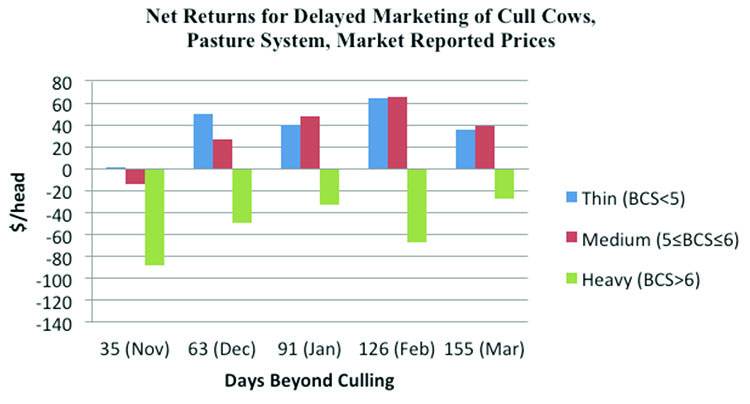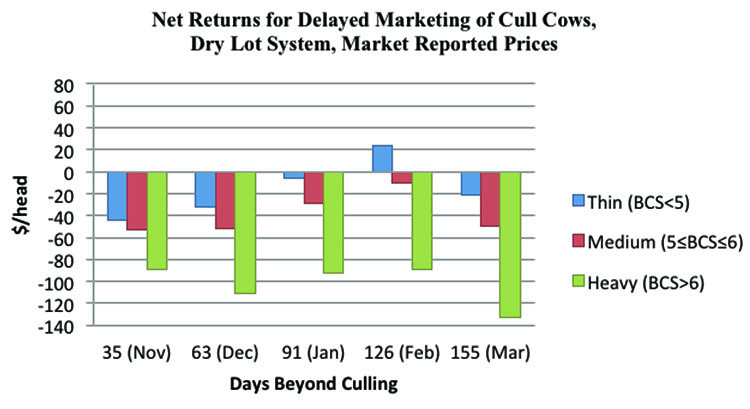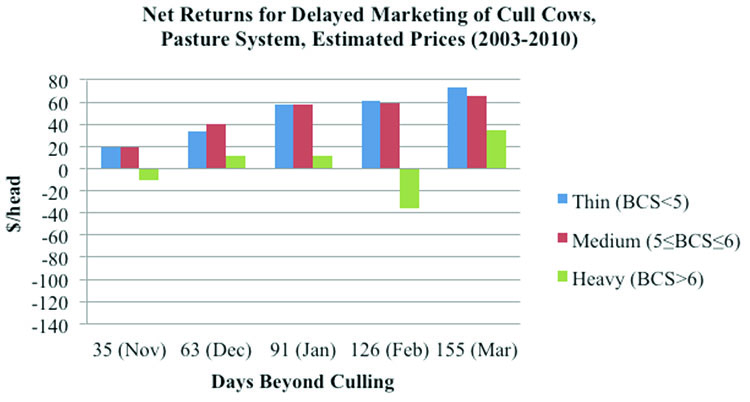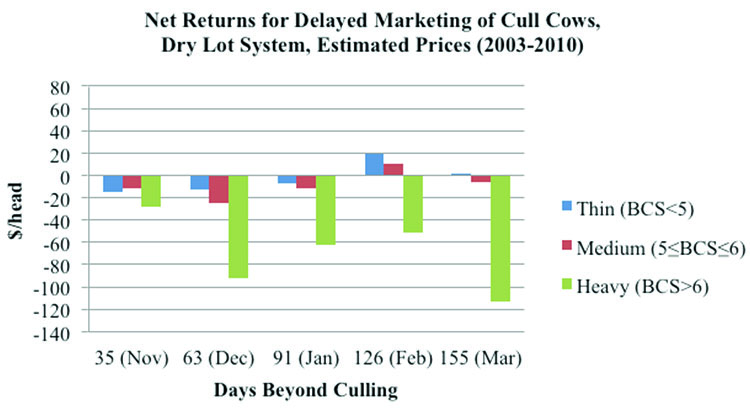Marketing Cull Beef Cows: Does Body Condition Score Matter?
- Jump To:
- Data and Methodology
- Results
- References
Cow-calf producers with spring calving herds typically wean calves from their mothers in late summer or early fall, and subsequently make decisions about culling cows from the herd. Alongside that culling decision is a marketing decision – the decision to market cull cows at culling time or retain them on the farm for marketing at a later date. Many factors influence this decision, including individual cow health, cash flow needs, on-farm resources for retention and feeding, current market conditions versus market expectations, and time. Historically, the seasonal price pattern for slaughter cows has the widest extreme from seasonal low to seasonal high of any class of cattle, offering producers an opportunity to add 10 percent to nearly 25 percent to the price for cull cows from the seasonal low to the following spring (Peel and Doye 2008). Figure 1 illustrates this seasonal movement from 2000 to 2009. Amadou et al. (2013) examine the profitability of retaining cows on native pasture versus a low-input dry lot setting. However, further research indicates that not only should producers consider the retention system type, but another factor should be considered when making the initial marketing decision – the cull cow’s body condition score (BCS) at the time of culling.
Body condition score plays a role in determining value at marketing and can be useful in making culling decisions, but there is little information on the influence of initial BCS on net returns from feeding cull cows (e.g. Strohbehn and Sellers 2002). Most cull cow marketing studies that discuss body condition score are focused on an improved BCS at marketing without fully accounting for costs (and potential benefits) of holding and feeding cull cows to obtain that higher BCS (e.g. Apple 1999; Carter and Johnson 2007). Cows with relatively low BCS (i.e. leaner) at culling should be more feed efficient in a retention setting, since a greater percentage of feed should go to weight gain rather than to weight maintenance relative to cows with higher BCS at culling. Cost of gain will likely be less for cows with lower initial BCS, enhancing the opportunity for positive net returns from retaining cull cows for a period rather than marketing them immediately at culling.
A 3-year joint study by OSU and The Samuel Roberts Noble Foundation examined the impact of initial BCS at culling time and differences in net returns from marketing cull cows at fall culling versus retaining cull cows for delayed marketing. Net returns were examined across five marketing periods (at culling and monthly through March) and two retention systems (native pasture and low-input dry lot) relative to BCS at culling as a sorting trigger. Cull cows were classified as thin (initial BCS<5), medium (5 initial BCS ≤ 6), or heavy (initial BCS>6) based on research and discussions with ranch managers regarding how they sort cows when addressing nutrition and feeding regimens (Encinias and Lardy, 2000).
Figure 1. Seasonal Price Index for Utility Cows in the Southern Plains, 2000-2009.
Data and Methodology
Spring calving cows were culled from a herd of black-hided Angus cows based on cow performance and breeding history. In each of the experiment years, cows were culled in October and marketed in March of the following year. Cows were randomly assigned to be retained in either a grazing environment (pasture) or in a minimal feed, low-cost dry lot environment (dry lot) with data collected at culling and then again at approximately monthly intervals and at marketing. Average cow age was six years old in October 2007, the first year of the experiment. There was little variation in age across the herd. A total number of 162 cows were included in the study across the three-year period, with 48 cows in year one, 43 cows in year two, and 71 cows in year three. In the dry lot system, cows were fed on a relatively low-cost ration consisting of rye hay and protein cubes. Rye hay with 10 percent crude protein was fed from mid-October to December, with 25 percent crude protein cubes fed for the remainder of the retention period. In the pasture system, cows were retained on stockpiled native grass pasture (350 acres) supplemented with hay and cubes only during icy periods. Both groups received mineral supplement.
Monthly measures were taken from culling through March of each year on individual cows and included weight, estimated USDA slaughter cow grade, body condition score and estimated dressing percentage. Cost data include feed, pasture, labor, and operating interest. Feed data include protein range cubes (pounds fed), mineral supplement (pounds fed), and hay (tons fed).
Cube and mineral prices were charged at local rates observed during the feeding period. Rye hay is priced at actual purchase price, which is also consistent with prices reported in the Oklahoma Market Report for Grass hay, east region during the study period (Oklahoma Department of Agriculture, Food and Forestry). A per acre cash rental rate is assigned to pasture costs based on local rates during the study, which are within the range of rates reported by Doye and Sahs (2011) for native pasture in the east region of Oklahoma. Feed costs are based on an “as fed” calculation by pen for each feeding period and are converted to a per cow average for individual cows based on management system and number of animals in the pen. Labor hours were tracked by feeding period for each system and assigned a wage rate consistent with the local wage for hourly ranch hands as reported by the Oklahoma Employment Security Commission’s Oklahoma Wage Report for Farming, Fishing, and Forestry for the years in the study period. Operating interest is charged at the annual rate of
7.5 percent on the estimated value of the cow at initial culling.
Price data for cull cows are taken from the Slaughter Cow portion of Agricultural Marketing Service’s (AMS) price reports KO_LS155 and KO_LS795 for Oklahoma National Stockyards, Oklahoma City. Two pricing methods were used for the analysis. The first method uses the actual market prices from the study period, while the second method uses historical prices from 2003-2010 to estimate a price function. Cow weight and quality grade were used to assign a slaughter cow price/cwt in each period and subsequently to calculate revenue. Net returns measure the difference in revenue at culling and revenue when marketing at a later date, less the associated retention and feed costs, written as:
Net Returns = Revenue at Marketing – Retention and Feed Costs – Revenue if sold at Culling
Negative net returns indicate the cow is best marketed at culling rather than retaining for marketing in the associated time period. Positive net returns across multiple periods can be compared to optimize the timing of cull cow marketing.
Results
Figures 2 and 3 illustrate cumulative average daily gain (ADG) for thin, medium and heavy cull cows in the pasture management system and the dry lot management system. Figure 2 illustrates that ADG of all cows generally decreased over time with ADG of thin cull cows higher than those of medium and heavy cows. Similarly, Figure 3 shows that ADG of all cull cows in the dry lot setting decreased with time, but the ADG of thin cull cows was higher than for medium and heavy cows in all but the first weigh period. This corresponds with the notion that as cows get heavier, more feed goes to weight maintenance as opposed to weight gain and feed efficiency decreases. Here, evidence supporting that theory is seen in both the dry lot and pasture management systems. Freetly and Nienaber (1996) also found that thin cows, defined as BCS<5 in their study, have potential for compensatory gain because of increased efficiency of energy use and nitrogen retention.
In previous research, Amadou et al. (2013) found that retaining cull cows in the native grass pasture system was generally more profitable than retaining them in the low-input dry lot system. When BCS scores at culling are also considered, thin and medium cows were typically more profitable in a retention system than cows with higher initial BCS, regardless of the feeding system as measured with actual market prices (Figures 4 and 5) or with estimated prices using historical data (Figures 6 and 7). Initial BCS appears to be an important influence on net returns from retaining and feeding cull cows beyond the culling date. As such, initial BCS should play an important role in the decision of whether to sell cull cows at the time of culling or to retain them for sale later when the typical seasonal price upswing occurs. Cows classified as heavy at culling generally yielded net returns from delayed marketing that were statistically zero or negative relative to revenue at culling, regardless of retention system or pricing method. Cows with lower initial BCS scores generally yielded positive net returns above revenue at culling in a native grass pasture retention system, though net returns were typically negative in the dry lot system. Highest net returns to retention are at or beyond 90 days. Average daily gain (ADG) decreased with time for each BCS category in each management system, but thin and medium cows tended to have higher ADGs than heavy cows in each system.
From a practical management perspective, study results suggest heavy cows should be sold immediately after culling. However, the seasonality of cull cow prices provides opportunity for increasing the cow’s salvage value for those cull cows with lower BCS at culling. Producers should make a retention decision annually for cull cows in the lower BCS categories considering the operation’s available and potentially underutilized forage resources, cash flow needs, input prices, and expectations of price movements. For more information on how to assign body condition scores to beef cows, see Selk (2004).
Figure 2. Cumulative Average Daily Gain from Culling to Marketing Period, Pasture System.
Figure 3. Cumulative Average Daily Gain from Culling to Marketing Period, Dry Lot System.
Figure 4: Net Returns ($/head) By Body Condition Score Across Marketing Periods for Cull Cows Retained in Pasture System, Market Reported Price.
Figure 5. Net Returns ($/head) By Body Condition Score Across Marketing Periods for Cull Cows Retained in Dry Lot System, Market Reported Price.
Figure 6. Net Returns ($/head) By Body Condition Score Across Marketing Periods for Cull Cows Retained in Pasture System, Estimated Prices (2003-2010).
Figure 7. Net Returns ($/head) By Body Condition Score Across Marketing Periods for Cull Cows Retained in Dry Lot Pasture System, Estimated Prices (2003-2010).
References
Amadou, Zakou, Kellie Curry Raper, Jon T. Biermacher, Billy Cook and Clement Ward. “Alternative Retention and Marketing Strategies for Cull Beef Cows.” Journal of the American Society of Farm Managers and Rural Appraisers Volume 76(1):248-267. 2013
Apple, J .K. “Influence of body condition score on the live and carcass values of cull beef cows.” Journal of Animal Science 77(1999):2610-2620.
Carter, J. N. and D. D. Johnson. Improving the Value of Cull Cows by Feeding Prior to Slaughter. Institute of Food and Agricultural Sciences, Florida Cooperative Extension Services, AN-169. 2007.
Encinias, A. M. and G. Lardy. “Body Condition Scoring I: Managing Your Cow Herd Through Body Condition Scoring.” North Dakota State University, Department of Animal and Range Sciences, AS-1026, December 2000.
Freetly, H.C., and J.A. Nienaber. “Efficiency of Energy and Nitrogen Loss and Gain in Mature Cows.” Journal of Animal Science 74(1996):1770-1776.
Peel, D.S. and D. Doye. Peel, D. S. and D. Doye. “Cull Cows Grazing and Marketing Opportunities.” Oklahoma Cooperative Extension Service Fact Sheet AGEC-613. Stillwater, Oklahoma 2008.
Selk, Glenn. “Body Condition Scoring of Beef Cows.” Oklahoma Cooperative Extension Service Fact Sheet ANSI-3283, 2004.
Strohbehn, D. R. and J. Sellers. “Economics of Adding Values to Cull Cows.” Iowa Beef Center. http://www.iowabeefcenter.org/pdfs/IQCCP/cc_econ_presnt.pdf. December 2002. Retrieved December 20, 2009.
Kellie Curry Raper
Associate Professor and Livestock Economist
Agricultural Economics
Jon T. Biermacher
Associate Professor and Agricultural Economist
The Samuel Roberts Noble Foundation, Inc.
Zakou Amadou
Former Research Assistant

